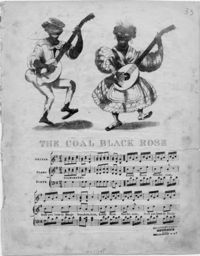Annotation:Coal Black Rose: Difference between revisions
m (Text replacement - "garamond, serif" to "sans-serif") |
No edit summary |
||
| Line 1: | Line 1: | ||
== | __NOABC__ | ||
<div class="noprint"> | |||
<p><font face="Century Gothic" size="4"> Back to [[{{BASEPAGENAME}}]] </font></p> | |||
</div> | |||
---- | ---- | ||
<p><font face=" | {{#lst:{{PAGENAME}}|abc}} | ||
---- | |||
<div style="page-break-before:always"></div> | |||
<p><font face="Century Gothic" size="2"> | |||
<div style="text-align: justify; direction: ltr; margin-bottom: 90px; margin-left: 70px; margin-right: 120px;"> | |||
<br> | |||
'''COAL BLACK ROSE'''. American, Minstrel Air (2/4 time). G Major (Kerr): C Major (Howe). Standard tuning (fiddle). AABB. The song is one of the earliest known blackface minstrel songs, dating from 1820, when it was popularized on stage by George Washington Dixon, followed by Thomas Blakeley and others. A farce, it tells of the fight between Cuffee and Sambo over a woman, a stereotyped comic black love triangle. | '''COAL BLACK ROSE'''. American, Minstrel Air (2/4 time). G Major (Kerr): C Major (Howe). Standard tuning (fiddle). AABB. The song is one of the earliest known blackface minstrel songs, dating from 1820, when it was popularized on stage by George Washington Dixon, followed by Thomas Blakeley and others. A farce, it tells of the fight between Cuffee and Sambo over a woman, a stereotyped comic black love triangle. | ||
[[File:coalblack.jpg|200px|thumb|left|Coal Black Rose songsheet, c. 1827]] | [[File:coalblack.jpg|200px|thumb|left|Coal Black Rose songsheet, c. 1827]] | ||
<br> | <br> | ||
< | </div> | ||
</font></p> | </font></p> | ||
<p><font face=" | <div class="noprint"> | ||
''Source for notated version'': | <p><font face="Century Gothic" size="2"> '''Additional notes''' </font></p> | ||
<p><font face="Century Gothic" size="2"> | |||
<font color=red>''Source for notated version''</font>: - | |||
<br> | <br> | ||
<br> | <br> | ||
</font></p> | </font></p> | ||
<p><font face=" | <p><font face="Century Gothic" size="2"> | ||
''Printed sources'': Chaff ('''The Complete Preceptor for the Banjo'''), 1851, p. 8. Howe ('''Complete Preceptor for the Accordeon'''), 1843; p. 18. Kerr ('''Merry Melodies'''), | <font color=red>''Printed sources''</font> : - Chaff ('''The Complete Preceptor for the Banjo'''), 1851, p. 8. Howe ('''Complete Preceptor for the Accordeon'''), 1843; p. 18. Kerr ('''Merry Melodies, vol. 3'''), c. 1880's; No. 294, p. 43. | ||
<br> | <br> | ||
<br> | <br> | ||
</font></p> | </font></p> | ||
<p><font face=" | <p><font face="Century Gothic" size="2"> | ||
''Recorded sources'': <font color=teal></font> | <font color=red>''Recorded sources'': </font> <font color=teal> - </font> | ||
</font></p> | </font></p> | ||
<br> | <br> | ||
---- | ---- | ||
== | <p><font face="Century Gothic" size="4"> Back to [[{{BASEPAGENAME}}]] </font></p> | ||
</div> | |||
__NOEDITSECTION__ | |||
__NOTITLE__ | |||
Revision as of 16:03, 10 November 2019
X:1 T:Coal Black Rose M:2/4 L:1/8 R:Minstrel Tune B:Elias Howe – Second Part of the Musician’s Companion (1843, p. 57) Z:AK/Fiddler’s Companion K:G Bdce|Bd A2|Bdce |dF G2:||:B2c2|BA G2| B/B/B/B/ ce|dF G2|B2c2 |BA G2|B/B/B/B/ ce|dF G2:|
COAL BLACK ROSE. American, Minstrel Air (2/4 time). G Major (Kerr): C Major (Howe). Standard tuning (fiddle). AABB. The song is one of the earliest known blackface minstrel songs, dating from 1820, when it was popularized on stage by George Washington Dixon, followed by Thomas Blakeley and others. A farce, it tells of the fight between Cuffee and Sambo over a woman, a stereotyped comic black love triangle.

